
Salicornia is a genus of succulent, halophytic flowering plants in the family Amaranthaceae that grow in salt marshes, on beaches, and among mangroves. Salicornia species are native to North America, Europe, South Africa, and South Asia. Common names for the genus include glasswort, pickleweed, picklegrass, and marsh samphire; these common names are also used for some species not in Salicornia. To French speakers in Atlantic Canada, they are known, colloquially, as "titines de souris". The main European species is often eaten, called marsh samphire in Britain, and the main North American species is occasionally sold in grocery stores or appears on restaurant menus, usually as 'sea beans' or samphire greens or sea asparagus.

Sarcocornia is a genus of flowering plants in the amaranth family, Amaranthaceae. They are known commonly as samphires, glassworts, or saltworts. The genus has a cosmopolitan distribution, and is most diverse in the Cape Floristic Region of South Africa.

The Salicornioideae are a subfamily of the flowering plant family Amaranthaceae. Important characters are succulent, often articulated stems, strongly reduced leaves, and flowers aggregated in thick, dense spike-shaped thyrses. These halophytic plants are distributed worldwide. Many are edible

Armeria maritima, the thrift, sea thrift or sea pink, is a species of flowering plant in the family Plumbaginaceae. It is a compact evergreen perennial which grows in low clumps and sends up long stems that support globes of bright pink flowers. In some cases purple, white or red flowers also occur. It is a popular garden flower and has been distributed worldwide as a garden and cut flower. It does well in gardens designed as xeriscapes or rock gardens. The Latin specific epithet maritima means pertaining to the sea or coastal.

Habenaria, commonly called rein orchids or bog orchids, is a widely distributed genus of orchids in the tribe Orchideae. About 880 species of Habenaria have been formally described. They are native to every continent except Antarctica, growing in both tropical and subtropical zones.

Polycarpon tetraphyllum, commonly known as four-leaved allseed, is a plant of the family Caryophyllaceae. An annual herb growing to 15 cm in height, it is found on sandy soils, in coastal areas and on wasteland. Native to Europe, it is also naturalised in parts of North America, Australia and elsewhere. It is rare in Britain, except in the Scilly Isles.
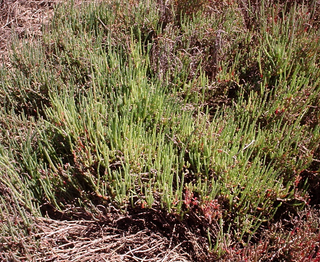
Tecticornia is a genus of succulent, salt tolerant plants largely endemic to Australia. Taxa in the genus are commonly referred to as samphires. In 2007, the genus Halosarcia, along with three other Australian genera was incorporated into the genus.
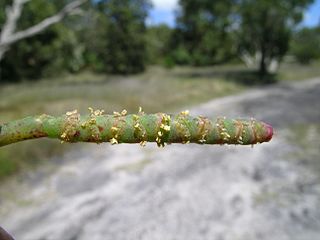
Sarcocornia quinqueflora, commonly known as beaded samphire, bead weed, beaded glasswort or glasswort, is a species of succulent halophytic coastal shrub. It occurs in wetter coastal areas of Australia and New Zealand.
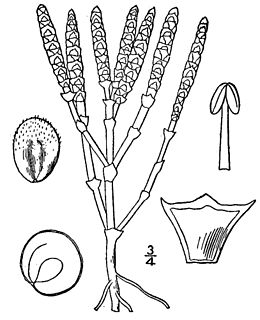
Salicornia bigelovii is a species of flowering plant in the family Amaranthaceae known by the common names dwarf saltwort and dwarf glasswort. It is native to coastal areas of the eastern and southern United States, Belize, and coastal Mexico. It is a plant of salt marshes, a halophyte which grows in saltwater. It is an annual herb producing an erect, branching stem which is jointed at many internodes. The fleshy, green to red stem can reach about 60 cm in height. The leaves are usually small plates, pairs of which are fused into a band around the stem. The inflorescence is a dense, sticklike spike of flowers. Each flower is made up of a fused pocket of sepals enclosing the stamens and stigmas, with no petals. The fruit is an utricle containing tiny, fuzzy seeds. The southern part of the species range is represented by the Petenes mangroves of the Yucatán, where it is a subdominant plant associate in the mangroves.
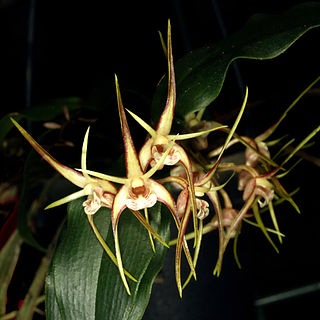
Dendrobium tetragonum, commonly known as the tree spider orchid, is a variable species of epiphytic or lithophytic orchid endemic to eastern Australia. Tree spider orchids are unusual in having pendulous pseudobulbs that are thin and wiry near the base then expand into a fleshy, four-sided upper section before tapering at the tip. There are only a few thin but leathery leaves at the end of the pseudobulbs and up to five flowers on relatively short flowering stems. To allow for the variations in the species there are five subspecies and a variety, some with a unique common name.

Suaeda nigra, often still known by the former name Suaeda moquinii, is a species of flowering plant in the amaranth family, known by the vernacular names bush seepweed or Mojave sea-blite.

Suaeda maritima is a species of flowering plant in the family Amaranthaceae known by the common names herbaceous seepweed and annual seablite.

Salicornia europaea, known as common glasswort or just glasswort, is a halophytic annual dicot flowering plant in the family Amaranthaceae. Glasswort is a succulent herb also known as ‘Pickle weed’ or ‘Marsh samphire’. As a succulent, it has high water content, which accounts for its slightly translucent look and gives it the descriptive name “glasswort.” To some people, it is known as “chicken toe” because of its shape. To others, it is called “saltwort.” It grows in various zones of intertidal salt marshes, on beaches, and among mangroves.
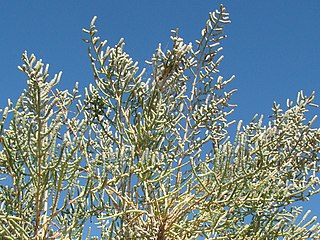
Halostachys is a genus of flowering plants in the plant family Amaranthaceae, containing a single species, Halostachys caspica. The plants are small to medium halophytic shrubs with apparently jointed fleshy stems and scale-like leaves. They are native to Asia and southeastern Europe.

Kalidium is a genus of flowering plants in the plant family Amaranthaceae. The species are shrubby halophytes distributed in Southeast Europe, Southwest Asia and Central Asia to China.

Symphyotrichum subulatum, commonly known as eastern annual saltmarsh aster or, in Britain and Ireland where it is naturalized, annual saltmarsh aster, is an annual plant in the family Asteraceae native to the eastern United States and the Gulf Coast to Texas. The species grows primarily in coastal salt marshes, although in the Ozarks it occurs as a non-marine weedy variety.

Arthrocaulon macrostachyum, synonym Arthrocnemum macrostachyum, is a species of flowering plant in the amaranth family. It is native to coastal areas of the Mediterranean Sea and the Red Sea and parts of the Middle East, where it grows in coastal and inland salt marshes, alkali flats, and other habitats with saline soils.
Arthrocnemum was a genus of shrubs in the family Amaranthaceae. Two or three species were included in the genus. They are halophytes with fleshy, apparently articulated plant stems and reduced leaves and flowers.
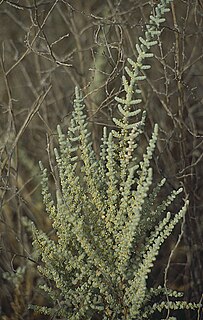
Halocnemum is a genus of halophytic shrubs in the family Amaranthaceae. The plants are fleshy and apparently articulated with characteristic globular or short-cylindrical lateral branches, and reduced leaves and flowers. There are two species, occurring from Southern Europe and North Africa to Asia.

Halopeplis is a genus in the family Amaranthaceae. The plants are halophytes with not articulated stems and fleshy stem-clasping leaves. There are three species, occurring from the Mediterranean basin and North Africa to Southwest Asia and Central Asia.

















